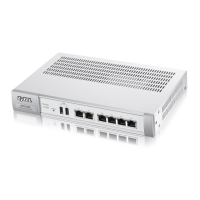Chapter 9 Interfaces
NXC Series User’s Guide
152
Subnet Mask This field is enabled if you set the Interface Type to internal or you select Use Fixed IP
Address.
Enter the subnet mask of this interface in dot decimal notation. The subnet mask indicates
what part of the IP address is the same for all computers in the network.
Gateway This field is enabled if you select Use Fixed IP Address.
Enter the IP address of the gateway. The NXC sends packets to the gateway when it does
not know how to route the packet to its destination. The gateway should be on the same
network as the interface.
Metric This field is enabled if you set the Interface Type to external or general and select Get
Automatically.
Enter the priority of the gateway (if any) on this interface. The NXC decides which gateway
to use based on this priority. The lower the number, the higher the priority. If two or more
gateways have the same priority, the NXC uses the one that was configured first.
IPv6 Address
Assignment
These IP address fields configure an IPv6 address on the interface itself.
Enable Stateless
Address Auto-
configuration
(SLAAC)
Select this to enable IPv6 stateless auto-configuration on this interface. The interface will
generate an IPv6 address itself from a prefix obtained from an IPv6 router in the network.
Link-Local
Address
This displays the IPv6 link-local address and the network prefix that the NXC generates itself
for the interface.
IPv6 Address/
Prefix Length
Enter the IPv6 address and the prefix length for this interface if you want to use a static IP
address. This field is optional.
The prefix length indicates what the left-most part of the IP address is the same for all
computers in the network, that is, the network address.
Gateway Enter the IPv6 address of the default outgoing gateway using colon (:) hexadecimal
notation.
Metric Enter the priority of the gateway (if any) on this interface. The NXC decides which gateway
to use based on this priority. The lower the number, the higher the priority. If two or more
gateways have the same priority, the NXC uses the one that was configured first.
DHCPv6 Setting
DHCPv6 Select N/A to not use DHCPv6.
Select Client to set this interface to act as a DHCPv6 client.
DUID This field displays the DHCP Unique IDentifier (DUID) of the interface, which is unique and
used for identification purposes when the interface is exchanging DHCPv6 messages with
others. See Appendix E on page 502 for more information.
DUID as MAC Select this if you want the DUID to be generated from the interface’s default MAC address.
Customized DUID If you want to use a customized DUID, enter it here for the interface.
Enable Rapid
Commit
Select this to shorten the DHCPv6 message exchange process from four to two steps. This
function helps reduce heavy network traffic load.
Note: Make sure you also enable this option in the DHCPv6 server to make rapid
commit work.
Request Address Select this to get an IPv6 address for this interface from the DHCP server. Clear this to not get
any IP address information through DHCPv6.
DHCPv6 Request
Options
If this interface is a DHCPv6 client, use this section to configure DHCPv6 request settings that
determine what additional information to get from the DHCPv6 server.
Add Click this to create an entry in this table. See Section 9.2.3 on page 156 for more
information.
Table 65 Configuration > Network > Interface > Ethernet > Edit (continued)
LABEL DESCRIPTION

